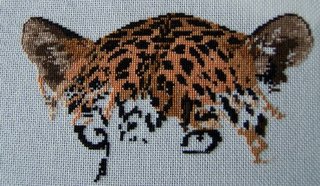
The jaguar has finally moved somewhat beyond the stage of its last picture, and of today, we have the sketches of eyes. This is important, because just beyond the eyes is the halfway point of the piece. It will be several days work to finish up just to the eyes, however.
Working over-one, I find it important to observe little niceties of stitching that I sometimes like to ignore in stitching over-two. It's not that it isn't important in stitching over-two, it just doesn't make as visible a difference. One is that it is important that all stitching moves in the same direction - start at the top and work down or start at the bottom and work up but don't change direction.
Another is that when stitching over one, it makes a huge difference for me if I stitch a row of stitches (all the same color) one half at a time and then return stitching the other half. Much neater tidier work. Oddly enough, this is not true with stitching over two. Then I do tidier work stitching one complete stitch at a time. Based on comments from others when this was discussed in a stitchery forum, many people find this dichotomy to be true, thus proving (again) that when taking or giving advice, it's necessary to be very careful you know what the basis one is working from.
A third thing that helps is making sure that one's thread is not too long. This may sound simplistic, but every time you start or stop a thread, you have to worry about the process of doing so. Repeatedly threading one's needle gets on some people's nerves. And WASTING THREAD is the bugaboo of some people's lives. I've seen people explain at great length the contortions that they go through to preserve a piece of ripped thread for re-use.
I'm sorry people, life's too short. Thread has a maximum number of passes through fabric before it visibly frays. This maximum number is based on how rough the fabric is, how close together the holes are and how many other stitches have already passed through that hole. I'm using 1/6th of a section of floss, cut in approximately 15 inch lengths. Floss comes 6 yards at a time and costs between 30 and 50 cents per hank. I use short lengths, and if it tangles or goes wrong and has to be ripped, I get a new piece.
The last thing that's true about stitching over-one really applies to any counted stitchery: Count and count and count again. Right now, at the bottom of the left hand side, there's another run of black stitches that needs to go down about 15 or 20 stitches. I'm tempted to just keep going with black, finish it off and be done with that color. I won't do it though - past experience tells me I'm going to get burnt if I do.
Counting for counted cross stitch works much better when you can count in two dimensions. When a new run starts down out into unexplored territory, it works much better if you can triangulate your work so that it has been count checked in both horizontal and vertical space. For example, when I started the left eye, I positioned it based on the orange bit just above it. As soon as absolutely practical, I confirmed its position by counting sideways to the bit coming down the nose. The bit extending south of the left eye is now confirmed only in one dimension. Any further extensions past that point are past my comfort zone for one dimensional exploration. It doesn't sound like much, but it means quite a lot when you get down farther later on and discover that one dimesional exploration was one stitch over and two stitches too long. How much other stuff have you got based on it by then that now has to be ripped?
Cross stitch is not particularly a creative outlet for me. I love doing it, but it's all about precision and following a pattern and making it look right. There's a part of me that is very satisfied with tweaking the surroundings of a pattern to make it mine and then being able to go with the flow that someone else has prepared. I used to do ccs during my break when I was working at one software company. My program manager one day asked me why, and I told him I enjoyed it because it was a lot like programming - very precise, very neat, and often very detailed. It was better than programming because I never had to rework it based on changing requirements.
I've noticed that I go back to doing ccs when other parts of my life are chaotic, with ever changing demands on my time.
No comments:
Post a Comment